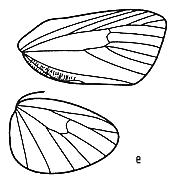
|
|
Utriculofera Hampson
Type
species:
fuscapex Hampson, Sri Lanka.
The two Oriental species have very different male genitalia. Those of the type species are distinguished by a very long, slender uncus, reduction of the distal three-quarters of the valve to a needle and, in the abdomen, the presence of small lateral coremata on the third segment (Fig 296). These features are absent from the second Oriental species, which has a setose structure between the valves similar to that seen in the Garudinia complex.
The female genitalia of the type species are delicate, the ductus narrow, with a slight distal expansion into the short neck of the bursa, the corpus of which is spherical and scobinate throughout. |
Copyright � Southdene Sdn. Bhd. All rights reserved.

